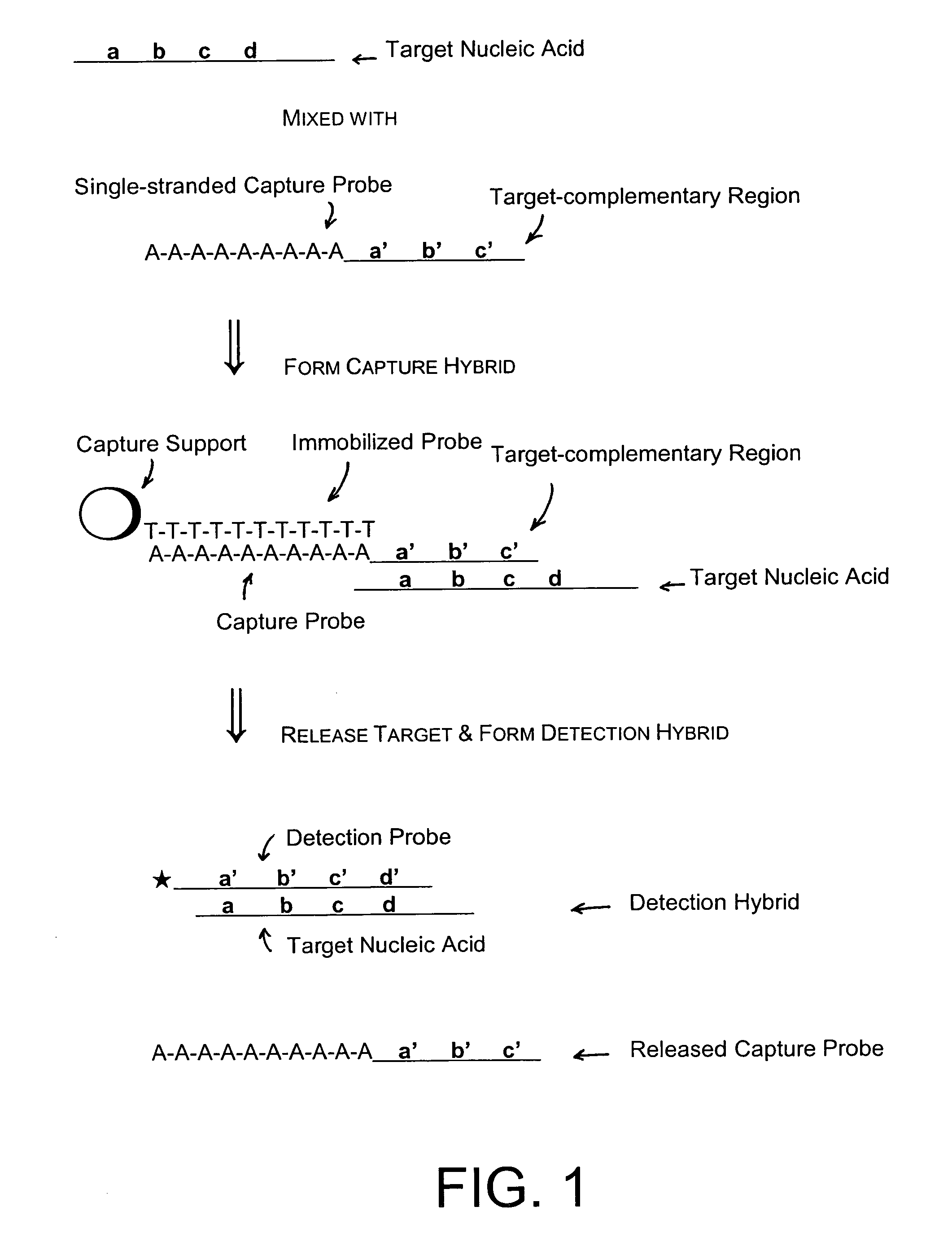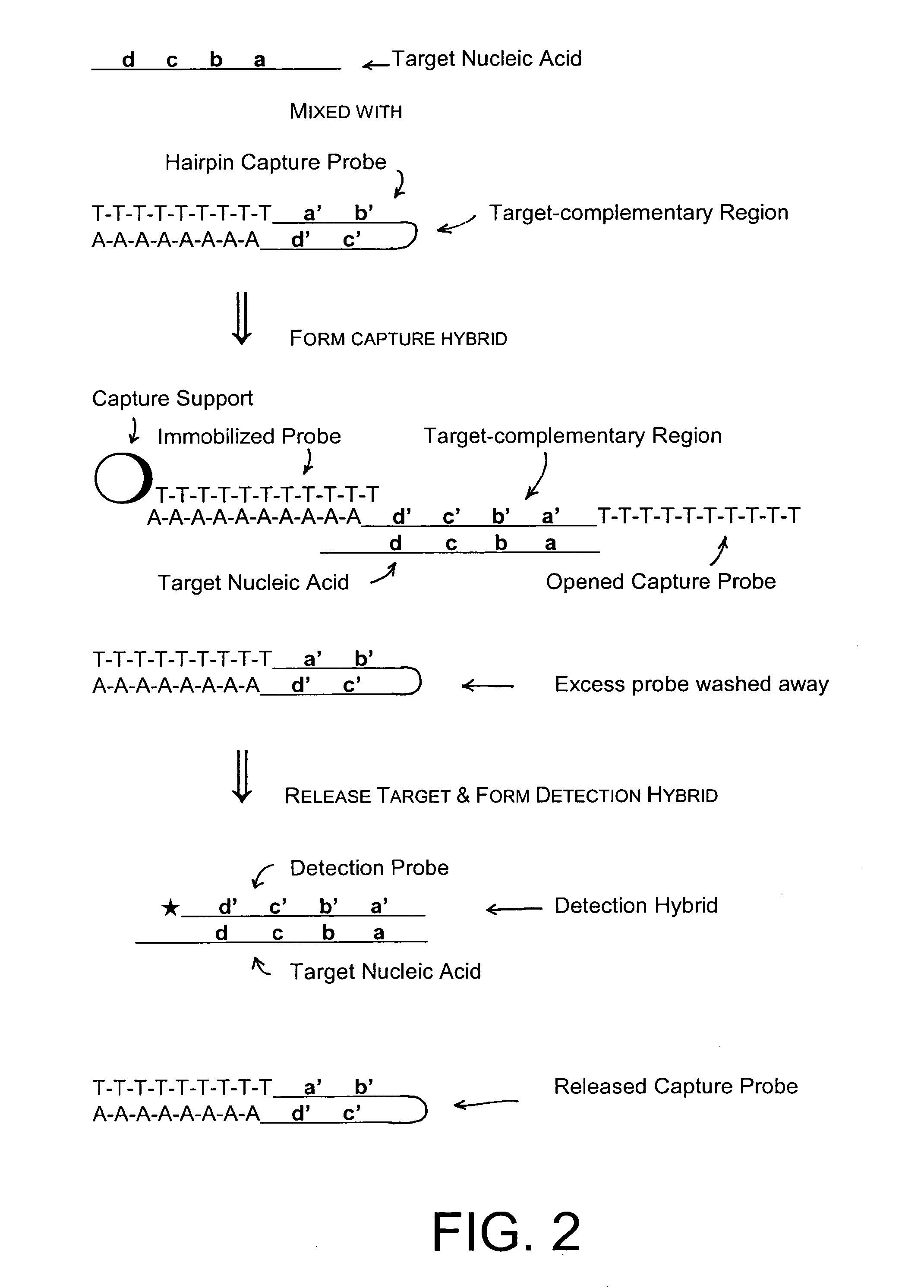Methods and compositions to detect nucleic acids in a biological sample
a biological sample and composition technology, applied in the field of nucleic acid assays, can solve the problems of affecting the detection accuracy of nucleic acids,
- Summary
- Abstract
- Description
- Claims
- Application Information
AI Technical Summary
Benefits of technology
Problems solved by technology
Method used
Image
Examples
example 1
Detection of Different Labeled Probes
[0050]To design detection probes, a target sequence of 23 nt was selected from a sequence common to genomic sequences of human Herpesvirus 5 (Cytomegalovirus) strains (Dunn et al., 2003, Proc. Natl. Acad. Sci. USA 100(24): 14223-14228; GenBank accession nos. AC146999, AC146851, and AY315197) and complementary to portions of fluorescent protein genes (GenBank accession nos. AY 303166, AY303167, and AY237157). Oligomers of 23 nt that were completely complementary to the target sequence were synthesized in vitro as a 2′-O-methyl oligoribonucleotides which had 52% GC content. Three versions of the probes were labeled with a linker at different positions (between bases 8 and 9, 12 and 13, and 13 and 14 of the 23-mer) and an AE label attached at the linker by using methods previously described in detail (U.S. Pat. Nos. 5,185,439, 5,283,174, and 5,656,744). The labeled probes (0.1 pmol per reaction) were individually hybridized at 60° C. for 1 hr to a c...
example 2
Sensitivity of Detection of Single-Stranded and Double-Stranded Targets
[0051]The sensitivity of target detection was determined by using the same target and detection probe sequences as in Example 1, but comparing detection of the RNA target when it was in ssRNA or dsRNA form. The ssRNA target oligomer and detection probe oligomer labeled with AE between positions 13 and 14 were used as in Example 1. In these assays, all reactions contained 0.1 pmol of the AE-labeled probe which was hybridized to the ssRNA target present in a range of 0 to 5 fmol per hybridization reaction (100 μl hybridization mixtures incubated at 60° C. for 1 hr). Following hybridization, the AE label on unbound probe was hydrolyzed by adding 200 μl of the selection reagent and incubating at 50° C. for 10 min, and then the chemiluminescent signal from bound probe was detected substantially as described in Example 1. Results shown in Table 1, columns 1 and 2, demonstrate that a linear detectable signal was measure...
example 3
Capture and Detection of a Target RNA
[0054]In these assays, a capture probe capable of forming a hairpin structure under hybridization conditions was used to capture a target nucleic acid from a sample, followed by hybridization of the target nucleic acid with a labeled detection probe and detection of a signal from bound detection probe. The capture probes used in these experiments all contain structural features that allow formation of a hairpin structure: a 5′ region homopolymeric sequence, a 3′ region sequence that was fully or partially complementary to the 5′ region sequence, and a target-complementary sequence flanked by the 5′ and 3′ region sequences. The 5′ and 3′ region sequences form the “stem” portion of the hairpin structure, and the target-complementary sequence forms the “loop” portion of the hairpin structure.
[0055]Three versions of a hairpin capture probe were synthesized and assayed using routine methods to determine the Tm of the stem of the hairpin capture probe....
PUM
| Property | Measurement | Unit |
|---|---|---|
| poly-dA | aaaaa | aaaaa |
| temperature | aaaaa | aaaaa |
| temperature | aaaaa | aaaaa |
Abstract
Description
Claims
Application Information
 Login to View More
Login to View More - R&D
- Intellectual Property
- Life Sciences
- Materials
- Tech Scout
- Unparalleled Data Quality
- Higher Quality Content
- 60% Fewer Hallucinations
Browse by: Latest US Patents, China's latest patents, Technical Efficacy Thesaurus, Application Domain, Technology Topic, Popular Technical Reports.
© 2025 PatSnap. All rights reserved.Legal|Privacy policy|Modern Slavery Act Transparency Statement|Sitemap|About US| Contact US: help@patsnap.com



